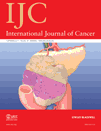Body weight at age 20 years, subsequent weight change and breast cancer risk defined by estrogen and progesterone receptor status—the Japan public health center-based prospective study†
Members of the Japan Public Health Center-based Prospective Study Group (principal investigator: S. Tsugane): S. Tsugane, M. Inoue, T. Sobue, and T. Hanaoka, National Cancer Center, Tokyo; J. Ogata, S. Baba, T. Mannami, A. Okayama, and Y. Kokubo, National Cardiovascular Center, Osaka; K. Miyakawa, F. Saito, A. Koizumi, Y. Sano, I. Hashimoto, and T. Ikuta, Iwate Prefectural Ninohe Public Health Center, Iwate; Y. Miyajima, N. Suzuki, S. Nagasawa, Y. Furusugi, and N. Nagai, Akita Prefectural Yokote Public Health Center, Akita; H. Sanada, Y. Hatayama, F. Kobayashi, H. Uchino, Y. Shirai, T. Kondo, R. Sasaki, Y. Watanabe, Y. Miyagawa, and Y. Kobayashi, Nagano Prefectural Saku Public Health Center, Nagano; Y. Kishimoto, E. Takara, T. Fukuyama, M. Kinjo, M. Irei, and H. Sakiyama, Okinawa Prefectural Chubu Public Health Center, Okinawa; K. Imoto, H. Yazawa, T. Seo, A. Seiko, F. Ito, and F. Shoji, Katsushika Public Health Center, Tokyo; A. Murata, K. Minato, K. Motegi, and T. Fujieda, Ibaraki Prefectural Mito Public Health Center, Ibaraki; K. Matsui, T. Abe, M. Katagiri, and M. Suzuki, Niigata Prefectural Kashiwazaki and Nagaoka Public Health Center, Niigata; M. Doi, A. Terao, Y. Ishikawa, and T. Tagami, Kochi Prefectural Chuo-higashi Public Health Center, Kochi; H. Sueta, H. Doi, M. Urata, N. Okamoto, and F. Ide, Nagasaki Prefectural Kamigoto Public Health Center, Nagasaki; H. Sakiyama, N. Onga, H. Takaesu, and M. Uehara, Okinawa Prefectural Miyako Public Health Center, Okinawa; F. Horii, I. Asano, H. Yamaguchi, K. Aoki, S. Maruyama, M. Ichii, and M. Takano, Osaka Prefectural Suita Public Health Center, Osaka; S. Matsushima and S. Natsukawa, Saku General Hospital, Nagano; K. Suzuki, Research Institute for Brain and Blood Vessels Akita, Akita; M. Kabuto, National Institute for Environmental Studies, Ibaraki; M. Yamaguchi, Y. Matsumura, S. Sasaki, and S. Watanabe, National Institute of Health and Nutrition, Tokyo; M. Noda, International Medical Center of Japan, Tokyo; S. Tominaga, Aichi Cancer Center Research Institute, Aichi; H. Shimizu, Sakihae Institute, Gifu; M. Iida, W. Ajiki, and A. Ioka, Osaka Medical Center for Cancer and Cardiovascular Disease, Osaka; S. Sato, Osaka Medical Center for Health Science and Promotion, Osaka; Y. Tsubono, Tohoku University, Miyagi; K. Nakamura, Niigata University, Niigata; Y. Honda, K. Yamagishi, and S. Sakurai, Tsukuba University, Ibaraki; M. Akabane, Tokyo University of Agriculture, Tokyo; T. Kadowaki, Tokyo University, Tokyo; Y. Kawaguchi, Tokyo Medical and Dental University, Tokyo; Y. Takashima, Kyorin University, Tokyo; H. Sugimura, Hamamatsu University, Shizuoka; H. Iso, Osaka University, Osaka; E. Maruyama, Kobe University, Hyogo; M. Konishi, K. Okada, and I. Saito, Ehime University, Ehime; N. Yasuda, Kochi University, Kochi; and S. Kono, Kyushu University, Fukuoka
Abstract
Few prospective studies have investigated the association between BMI at age 20 years (BMI20y) and breast cancer risk with consideration to estrogen/progesterone receptor status (ER/PR). We evaluated the association between BMI20y and ER/PR-defined breast cancer risk among 41,594 women in the population-based Japan Public Health Center-based Prospective Study. Anthropometric factors were assessed using self-reported questionnaires. Relative risks (RRs) were estimated by Cox proportional hazards regression models. Through to the end of 2006, 452 breast cancer cases were identified. We observed a statistically significant inverse association between BMI20y and breast cancer incidence [multivariable-adjusted RR for each 5-unit increment 0.75 (95%CI = 0.61–0.92)], which was not modified by menopausal or recent BMI status. In contrast, recent BMI and subsequent BMI gain were not associated with increased risk among premenopausal women, but were substantially associated with increased risk among postmenopausal women [corresponding RRrecent BMI = 1.31 (95%CI = 1.07–1.59); RRsubsequent BMI gain = 1.32 (95%CI = 1.09–1.60)]. In subanalyses by receptor status (∼50% of cases), the observed inverse association of BMI20y with risk was consistent with the result for ER–PR– [0.49 (95%CI = 0.27–0.88)], while the observed positive associations of BMI gain with postmenopausal breast cancer risk appeared to be confined to ER+PR+ tumors [corresponding RRfor subsequent BMI gain =2.24 (95%CI = 1.50–3.34)]. Low BMI at age 20 years was substantially associated with an increased risk of breast cancer. In contrast, high recent BMI and subsequent BMI gain from age 20 were associated with increased risk of postmenopausal ER+PR+ tumors.




